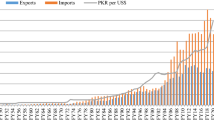Summary
Nowadays it is uncontested that price elasticities of demand for exports and imports are high enough to secure an improvement of the current account of the balance of payments in the case of an exchange rate devaluation. Indeed it may take some time until the effects materialize and the primary effect may even run in the opposite direction. However, doubts arise about the favourable reaction of the current account if secondary price and wage effects are taken into consideration—what has been done more thoroughly in recent times.
The present study deals with the medium term aspects of exchange rate changes in Austria. In order to quantify exchange rate effects on foreign trade and prices double weighted exchange rate indices and double weighted foreign trade price indices were computed and a simple econometric model was built. Behavioural equations for quantities and prices of exports and imports (as far as possible, disaggregated for raw materials, energy and manufactures), for domestic prices and wages were estimated. In addition to this model exchange rate effects on tourism were considered separately. In order to evaluate the consequences of the revaluation of the Austrian Schilling simulations were run under the assumption that in the period 1972 till 1976 Austria had kept constant the average exchange rate of the currencies of its main trading partners (competitors). The main results are as follows: If Austria had pursued a constant exchange rate policy in terms of the export weighted exchange rate index during the years 1972 to 1976 instead of actually revaluating the Schilling by 19 percent the volume of exports would have been higher by 1 billion Schilling (at 1970 prices) whereas the volume of imports would have been lower by 16 billions Schilling; measured in current prices exports and imports would have been higher by 59 billions and 60 billions, respectively, and the receipts from tourism would have grown faster by 12 billions. Therefore, the trade balance would have deteriorated by 1 billion and the current account would have improved by 11 billions. By 1976 consumer prices and wages would have reached a higher level (+7 3/4 percent and +5 1/4 percent, respectively). The results of this study are not in contradiction to those obtained in comparable work for other countries.
There is some indication pointing to a further deterioration of the current account in the longer run: The revaluation caused profit squeeze which hits exporters as well as import competing domestic producers may weaken investment and the ability to maintain market shares. The revaluation could favour the sheltered sector of the economy in comparison to the exposed sector and shift the structure of the economy to the disadvantage of the current account.
Similar content being viewed by others
Literaturverzeichnis
J.R. Artus: The Behaviour of Export Prices for Manufactures, inClark-Logue-Sweeney (1974).
J.R. Artus: The 1967 Devaluation of the Pound Sterlin, IMF Staff Papers, November 1975.
R.J. Ball-T. Burns-J.S.E. Laury: The Role of Exchange Rates in Balance of Payments Adjustment: The United Kingdom Case, The Economic Journal, March 1977.
F. Breuss: Potential Output-Ein Beitrag zur Messung gesamtwirtschaftlicher Kapazitätsauslastung und konjunktureller Ungleichgewichte, Empirica 2/1975.
P.B. Clark-D.E. Logue-R.J. Sweeney: The Effects of Exchange Rate Adjustments, Department of the Treasury, Washington 1974.
M.C. Deppler: Some Evidence on the Effects of Exchange Rate Changes on Trade, IMF Staff Papers, November 1974.
H. Handler: A Brief Survey of Empirical Evidence on Income and Price Effects on Austrian External Transactions, Unveröffentlichtes Manuskript, 1978.
J. Horne: The Effect of Devaluation on the Balance of Payments and the Labour Market: United Kingdom 1967, Economica, February 1979.
K. Köhler: Rohstoffpreisindizes-Methodik und Aussagefähigkeit, Bremer Ausschuß für Wirtschaftsforschung, 1976.
M.E. Kreinin: The Effect of Exchange Rate Changes on the Prices and Volume of Foreign Trade, IMF Staff Papers, July 1977.
S.Y. Kwack (1974 A): Simulations with a Model of the US Balance of Payments: The Impact of the Smithsonian Exchange-Rate Agreement, inClark-Logue-Sweeney (1974).
S.Y. Kwack (1974 B): The Effect of Foreign Inflation on Domestic Prices and the Relative Price Advantage of Exchange-Rate-Changes, inClark-Logue-Sweeney (1974).
E.E. Leamer-R.M. Stern: Quantitative International Economics, Boston, Mass. 1970.
I. Prucha: The Real Sector of Model LIMA 79/8, Institutsarbeit Nr. 118, Institut für Höhere Studien, September 1979.
K. Rose: Theorie der Außenwirtschaft, 2. Auflage, Berlin-Frankfurt 1966.
F. Schebeck-H. Suppanz-G. Tichy: Preis- und Wechselkursindizes für den Export österreichischer Halb- und Fertigwaren, Empirica 2/1974.
F. Schebeck-G. Thury: WIFO-JMX — An Annual Ecopnometric Macro Model of the Austrian Economy, Empirica 1/1979.
St. Schulmeister: Reiseverkehr und Konjunktur, Wien 1977.
St. Schulmeister: Modellprognosen für den Reiseverkehr, Wien-Stuttgart 1978.
St. Schulmeister: Tourism and the Business Cycle, Wien 1979.
H. Seidel: Der effektive Wechselkurs des Schillings, Monatsberichte des Österreichischen Institutes für Wirtschaftsforschung 8/1978.
E. Smeral: Ein gesamtwirtschaftliches Allokationsmodell: Das Linear-Expenditure-System im Falle Österreichs, Empirica 1/1978.
G. Tichy: Die Situation Österreichs im internationalen Wettbewerb, Quartalshefte der Girozentrale, 4/1978.
A. Wörgötter: Lohn- und Preisgleichungen für Österreich, Empirica 1/1975.
Rights and permissions
About this article
Cite this article
Schebeck, F., Suppanz, H. & Tichy, G. Die mittelfristigen Folgen der Wechselkurspolitik für Leistungsbilanz und Inflationsrate. Empirica 7, 139–167 (1980). https://doi.org/10.1007/BF00924949
Issue Date:
DOI: https://doi.org/10.1007/BF00924949




